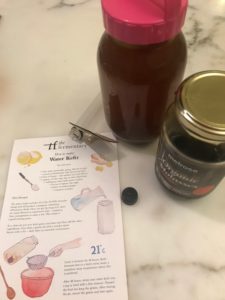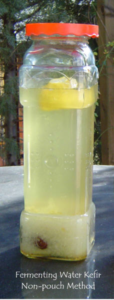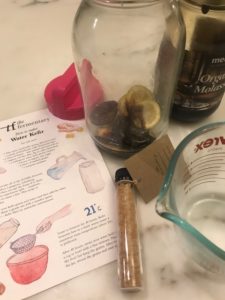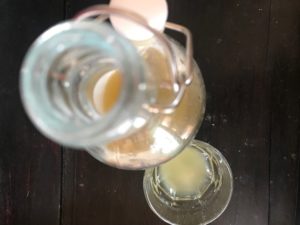Has anyone else tried making water kefir and failed or felt like you’ve failed because you’re not sure that what you’ve created is actually the real deal?
I can smash out an awesome Kombucha tea in a multitude of flavours, so when my 3rd attempt at water kefir was sadly more than a little insipid, I asked a good client if she’d lend us all her recipe. Wendy’s been using this recipe successfully for years.
Even initially, as I read Wendys recipe I felt relieved – it answered all my lingering questions I’d had with other recipes and let’s just say the results were a winner (and my self-esteem even felt renewed.)
Enjoy!
Wendy’s Water Kefir
 Ingredients:
Ingredients:
- Kefir grains
- 100 grams Sugar
- Molasses
- Dried fruit
- 1 Lemon
- Fruit juice
- 1 Lemon
- Ginger and turmeric
Method:
Starting
- Strain the liquid from the kefir grains that have been resting in the jar with the water and molasses/sugar. Use a plastic or bamboo sieve to drain the grains. Some references say that the grains shouldn’t come in contact with metals.
- You could drink the strained molasses water (I don’t – only because I don’t like the taste).
 To make the first ferment (main kefir water)
To make the first ferment (main kefir water)
- Put the grains into to a large glass container (bigger than 1 litre jar).
- For every 3 tablespoons of grains add:
1 litre of water(Most references say you need to remove the chlorine from the tap water as the chlorine will over time kill the grains. I’ve found my grains do best in regular Melbourne tap water.)
50 grams of sugar (I use 2/3 raw sugar and 1/3 rapadura/panela sugar)
2 pieces of organic dried fruit (I use dried apricots and figs. I wrap the dried fruit in some cheese cloth, so it doesn’t breakdown in the brew.)
- Add ½ a lemon to the container (a full lemon cut in half once you are brewing 2+ litres).
- Mix in glass container and stir.
- Seal the container.
- Let stand for 3-7 days out of direct sunlight.
The fermenting time is very dependent on the room temperature. In a cool room in winter it could take 7+ days to ferment. In February it can take 2-3 days.
It can be a bit tricky to determine when it is ready – and other than in very hot weather, you really have quite a few day’s grace. It tends to be ready when the grains have been ‘dancing/jumping’ in the water for a good couple of days, the sugar has dissolved and there are tiny bubbles at the surface. - If you don’t have time to make the second ferment when its ready, put the whole sealed jar in the fridge until you do have time. I’ve left it in the fridge for about a week after its fermented.
 To make the second ferment (tends to be much tastier and has a fizz)
To make the second ferment (tends to be much tastier and has a fizz)
- Strain the liquid from the kefir that has been brewing in the large jar with the grains.
- Put the grains aside to rinse.
- Squeeze some of the juice of the lemon into it (this is now the water kefir and you can also drink it after the first ferment).
- Split the first ferment water kefir into glass bottles (that have a good seal) and mix with apple juice (anywhere from a ¼ to ½ juice depending on how sweet you like it). I also add spices such as ginger and turmeric. You can experiment with any juice.
- Seal these bottles and leave on the bench for another 24-48 hours.
- Once the shorter 2nd fermented has finished (24-48 hours), store bottles in fridge – they are ready to drink and also keep for weeks (probably months).
- The effervescence will depend on the quality of the bottle’s seal, how much acid you add with the lemon juice and also the amount of sugar you add with the fruit juice. If the bottle has a strong seal – open your chilled bottle over the sink and a jug as it may well spurt!
Clean
- Rinse the grains using water and a plastic sieve.
- Clean the container – only use detergent when necessary – I use a brush that I keep separate from normal dishwashing brushes.
- Start the cycle all over again.
 Resting
Resting
When you tire of making the kefir, you can ‘rest’ the grains in a smaller jar of water and molasses (or sugar) in the fridge. They will keep alive this way for a month. If you want to keep them longer – then refresh the water and feed with more molasses or sugar.
Happy brewing! These instructions look more daunting than what it really is. Once you have the knack of it, it is very simple.
—Wendy
—
References
https://www.growyouthful.com/recipes/water-kefir.php This link has great info – though recommends using molasses – we don’t like the taste of it with molasses. I use two-thirds raw sugar, and on-third rapadura sugar (to keep the cost down a little). I find using some rapadura sugar keeps the grains healthier.
https://tibicos.org/faq/ has possibly the best FAQ section I have found and talks about the second ferment – which I think is what gives it a yummy taste and lots of fizz.







